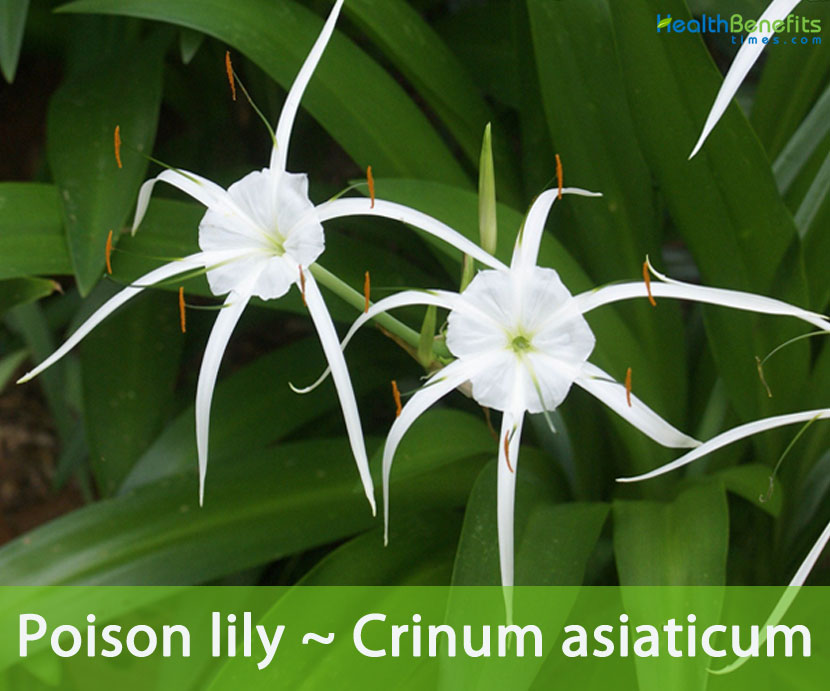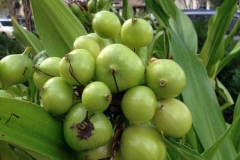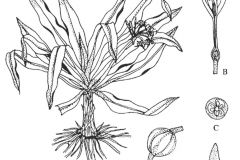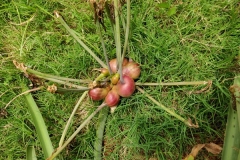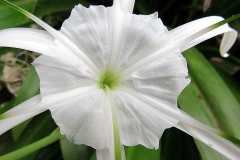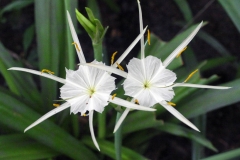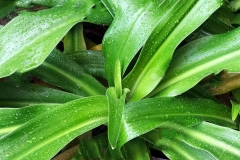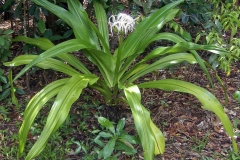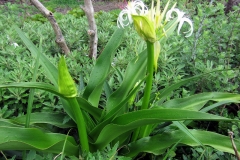| Poison bulb or Poison lily Quick Facts | |
|---|---|
| Name: | Poison bulb or Poison lily |
| Scientific Name: | Crinum asiaticum |
| Origin | Indian Ocean islands, East Asia, tropical Asia, Australia and Pacific islands |
| Colors | Green or light green |
| Shapes | Oblate irregularly globose capsule, 2.5-6.5 cm across, with one or a few large green seeds |
| Taste | Sweet, pungent |
| Health benefits | Good for boils, contusions, earache, edema, fever, fractures, gastrointestinal complaints, hernia, mumps, rheumatism, tonsillitis, urinary difficulties and vomiting |
| Name | Poison lily |
|---|---|
| Scientific Name | Crinum asiaticum |
| Native | Indian Ocean islands, East Asia, tropical Asia, Australia and Pacific islands. It is regarded as naturalized in Mexico, the West Indies, Florida, Louisiana, numerous Pacific islands, Madagascar and the Chagos Archipelago |
| Common Names | Nagdaman, Sukhdarshan, Sudarshan, Grand Crinum Lily, Poison Bulb, Spider Lily, Seashore Lily, Bakung, Crinum Lily, Asiatic Poison Lily, Seashore Crinum, Bawang Hutan, Giant Crinum, White Crinum, Grand Crinum, Giant Crinum |
| Name in Other Languages | Arabic: Haliyaon Assamese: Bon-naharu (বন নহৰু), bon nohoru, dheki phul (ঢেকি ফুল), jajang (জজং), konari (কনাৰী), nagdamini (নাগদামিনী), sukhdarsan (সুখদৰ্শন) Bengali: Sookhdursun, Bara Kanur, , Sukhadarshana (সুখদর্শন), Banakanur, baro kanur (বড়ো কানুর), koba rasun (কোবা রসুন), nagdala (নাগদল), nagdamini (নাগদামিনী), sudarsan (সুদর্শন), sukhadarshana (সুখদর্শন) Bulgarian: aziat·ski krinum (азиатски кринум) Burmese: Koyangi, g mone ko ran kyee (ဂမုန်းကိုယ်ရံကြီး) Ceylon: Vishamungil Chamorro: Piga-palayi Chinese: Wen shu lan (文殊兰),Quen chou lan, Wénzhū lán (文珠蘭) Chuukese: Giob, kiiyopw, kiop, kiopw, kiopw pwuniwal, kiyopw, mwootiw, püllai, pullai, siipw Cohin: Mansylan Czech: Křín asijský English: Asiatic poisonbulb, crinum, false spider lily, giant crinum lily, grand crinum, poisonbulb, spider lily, white spider lily, crinum lily, poison lily, swamp lily, Antidote Lily, cape lily flowers, Crinum lily Fijian: Lautalotalo, viavia Finnish: Aasiankriinumi German: Weiße Hakenlilie, Asiatische Hakenlilie Gujarati: Nagdowan, Nagadamani, Nagrikanda, nagdamani (નાગદમની), sukhdarshan (સુખદર્શન) Hindi: Sudharshan (सुदर्शन), Nagadamani (नागदामिनी), Shukadarsana, Chindar, Pindar, Badakanvar, Chintaara I-Kiribati: Te kiebu, te kiepu, te ruru, te ruru n aine Indonesian: Bakong, bakung, kajang-kajang, fete-fete Japanese: Taiwan-hamaomoto, hamawomoto (ハマオモト), hamayū (ハマユウ), Kannada: Naagdaali (ನಾಗದಾಳಿ), vishabiduru (ವಿಷಬಿದುರು), vishamunguli (ವಿಷಮುಂಗುಲಿ) Kwara‘ae: Afamanu, arakao Konkani: Kartmari, Kirathi Maari, nagdavan (नागदवण) Korean: Munjulan (문주란) Lakhimpur: Kaneripat Malay: Pokok Bakung Malayalam: Pulattali, Puzhatthali, visamoolam, veluttapolatali (വെളുത്തപോളതാളി) Malaysia: Bakong, bawang hutan Mangarevan: Riri Marathi: Gadambi Kanda, bhuishirad (भुईशिरड), nagadamani (नागदमनी), nagadavana (नागदवण) Marshallese: Kieb, kiebe, kiep, kiup Nauruan: Dagibu, dagiebu Nepali: Haade Phool (हाडे फूल) Niuean: Lili, talotalo Odia: Arisa (ଆରିସା), dhinkiadala (ଢିଙ୍କିଆ ଦଳ), nagadamani (ନାଗଦମନୀ), Arsa, Hatikanda Palauan: Bisecherad ra ngebard Papua New Guinea: Morabau, didil, pokaan Persian: Marchobia, سوسن عنکبوتی Philippines: Bakong, agabahan, biliba Pingelapan: Khepw, kiep Pohnpeian: Kiepw Portuguese: Crino-branco, crino, lírio-do-Cabo Russian: Krinum aziatskiy (Кринум азиатский) Samoan: Lau talotalo Sanskrit: Sudarshana, sudarshan, vishamandala, nagadamani, somavalli, cakrangi, madhuparnila, nagadamani (नागदमनी), sudarsana (सुदर्शन), vishamandala (विषमण्डल) Sinhalese: Tobalo Spanish: amancay, lirio de cinta Swedish: Strandkrinum Tahitian: Eriri Tamil: Visamumgil (விஷமூங்கில்), Vishapungila, nari-venkayam (நரிவெங்காயம்), peru-narivenkayam (பெருநரிவெங்காயம்), visa-munkil (விஷமூங்கில்) Telugu: Kesar chettu, lakshminarayana chettu, Ceṅgalva (చెంగల్వ), Vishamugali, chengaluva (చెంగలువ), kesarchettu (కేసరచెట్టు), lakshminarayana chettu (లక్ష్మీనారాయణచెట్టు), visha-mungali (విషమంగలి) Thailand: Phlapphueng (พลับพลึง), lilua Tokelauan: Lau talotalo Tongan: Sāmoa, talotalo, tolotalo Tuamotuan: Riri Tulu: Isamungili (ಇಸಮುಂಗಿಲಿ) Tuvaluan: Talotalo, tapua, te luhe Ulithian: Giab, hiop Urdu: Nagdaun, sukhdarshan Vietnam: Náng hoa trắng, tỏi voi, lá náng, Náng Wallisian: Talotalo Woleaian: Giop, giyob Yapese: Giobwutet, giop, guyab |
| Plant Growth Habit | Erect, herbaceous, terrestrial, perennial, ornamental, bulbous plant |
| Growing Climates | Sandy beaches, other coastal areas, cliff and steep slopes, borders of coastal forests, mangrove forests and at low altitudes |
| Soil | Prefers a deep, well-drained but moisture-retentive fertile soil that is rich in organic matter |
| Plant Size | 5 feet (1.5 m) tall and a greater spread of about 7 feet (2 m) |
| Root | Fibrous, adventitious root system |
| Stem | Contracted, rounded, solid |
| Leaf | Simple, narrowly lanceolate, acuminate, in a dense rosette atop the stem, blade is sessile, linear-lanceolate, usually 60-130 cm long and 10-15 cm wide, thick and somewhat fleshy |
| Flowering season | June to August |
| Flower | Flowers more or less continuously through the year; flowers 20 to 30 or more, fragrant, borne in an umbel atop a long, thick stalk and enclosed within two large bracts. Corolla with fused tepals, funnel-shaped, the tube above the ovary 8-12 cm long, 4-7 mm in diameter, greenish, the limb of six spreading segments 6-12 x 0.7-1.5 cm, usually white, with six long, protruding stamens with red filaments |
| Fruit Shape & Size | Oblate irregularly globose capsule, 2.5-6.5 cm across, with one or a few large green seeds |
| Fruit Color | Green – Light Green |
| Seed | Seeds are 2-4.5 cm wide, large and exotesta spongy. |
| Propagation | By seed or by division |
| Taste | Sweet, pungent |
| Plant Parts Used | Leaves, roots, bark, fruit, seeds, flowers |
| Other Facts |
|
Plant Description
Poison lily or poison bulb is an erect, herbaceous, terrestrial, perennial, ornamental, bulbous plant with a flowering stalk in the center of the plant. The plant normally grows about 5 feet (1.5 m) tall and a greater spread of about 7 feet (2 m) from an underground bulb that can be 5 – 15cm in diameter. The plant is found growing in sandy beaches, other coastal areas, cliff and steep slopes, borders of coastal forests, mangrove forests and at low altitudes. The plant prefers a deep, well-drained but moisture-retentive fertile soil that is rich in organic matter. The plant has fibrous, adventitious root system and contracted, rounded and solid stem.
Leaves
Stalk less leaves are simple, narrowly lanceolate, acuminate, in a dense rosette atop the stem, blade is sessile, linear-lanceolate, usually 60-130 cm long and 10-15 cm wide, thick and somewhat fleshy, stalkless parallel veined with many cross veins and is light green colored. Leaves have a hairy texture.
| Foliage Retention | Evergreen |
| Mature Foliage Color(s) | Green – Light Green |
| Mature Foliage Texture(s) | Smooth |
| Foliar Type | Simple / Unifoliate |
| Foliar Arrangement Along Stem | Rosulate / Rosette |
| Foliar Attachment to Stem | Sessile |
| Foliar Shape(s) | Non-Palm Foliage (Lanceolate) |
| Foliar Venation | Parallel |
| Foliar Margin | Entire, Entire – Wavy / Undulate |
| Foliar Apex- Tip | Acute |
| Foliar Base | Truncate / Square |
| Leaf Area Index (LAI) for Green Plot Ratio | 3.5 (Shrub & Groundcover – Monocot) |
Flower
The inflorescence is umbel that has 10-24 flowers, multiple petals and aromatic. Flower stem is erect, as long as the leaf, solid. Spathe is lanceolate, membranous, 6–10 cm. Bractlet is liner, 3–7 cm. Perianth tube slender and straight, green white, 7–10 cm, diameter 1.5–2 mm. Corolla is spider-like shaped, white, linear, revolute, attenuate, 4.5–9 cm long and 6–9 mm wide. Corolla lobes 6. Pedicel is 0.5-2.5 cm long. Stamens are reddish colored. Filaments are 4–5 cm long. Anthers are liner, attenuate, ca. 1.5 cm long or more. Ovary is fusiform, up to 2 cm long. Flowering normally takes place in between June to August. Flowers are fragrant at night.
| Flower & Plant Sexuality | Bisexual Flowers |
| Flower Color(s) | White |
| Flower Grouping | Cluster / Inflorescence |
| Flower Location | Terminal |
| Flower Symmetry | Radial |
| Individual Flower Shape | Tubular |
| Flower Size – Width | 20 cm |
| Inflorescence Type | Umbel |
Fruit
Fertile flowers are followed by oblate irregularly globose capsule, 2.5-6.5 cm across, with one or a few large green seeds. Seeds are 2-4.5 cm wide, large and exotesta spongy.
| Mature Fruit Color(s) – Angiosperms and Gymnosperms | Green – Light Green |
| Mature Fruit Texture(s) | Glossy / Shiny |
| Fruit Classification | Simple Fruit |
| Fruit Type | Fleshy Fruit |
Traditional uses and benefits of Poison lily
- Leaves are boiled and used as a bath, or the juice applied as a thick liquid to treat edema.
- Leaves are wilted over hot charcoal and wrapped around the knees for swollen knees, or placed on the back for about one hour for backaches.
- Leaf and bulb are used to neutralize poisons and regulate flatulence, phlegm, and urine.
- Bulb is ground to make a paste for reducing the heat from swellings or for weeping sores (this paste, however, causes some itching).
- The bulb consists of alkaloids, notably lycorine and crinamine.
- Poultice made from the heated, pounded, fresh bulb is used to relieve osteodynia and rheumatism.
- Juice of the fresh bulb is used as an emetic, whilst it is also instilled in the ear to treat Otis.
- Poultice of the heated, pounded, fresh leaves is used to treat contusions, sprains, closed fractures, luxation etc.
- Decoction of the dried leaves is used as a wash in the treatment of hemorrhoids.
- Leaves are applied on swellings and the roots are given to ease childbirth in Papua New Guinea.
- The hair like threads from the stem is used to poultice cuts.
- Plant is used to treat infections of the breast and wounds in Fiji.
- The crushed leaves are used to wash piles.
- Mixed with honey, they are applied to wounds and abscesses.
- Leaves and bulbs can be used to induce vomiting, because they consists of the alkaloid lycorine.
- In ethno-medicine, it is used to relieve anguish from a plethora of ailment conditions such as boils, contusions, earache, edema, fever, fractures, gastrointestinal complaints, hernia, mumps, rheumatism, tonsillitis, urinary difficulties and vomiting, amongst others.
- The plant or plant part is used for gastrointestinal disorders, skin diseases, fever, earache, boils, tonsillitis, mumps, hernia, rheumatism, urinary troubles, bone fracture, edema, and also as an antidote to poison.
- Folk herbalists of the Tipuri tribe in Tripura use the bulbs of the plant to treat tonsillitis.
- The Gonds of Andhra Pradesh consume the roasted bulbs to kill worms in the stomach and also as an aphrodisiac.
- In Varanasi, Uttar Pradesh the bulbs are roasted and eaten to cure rheumatism and piles.
- It has been used in Thai traditional medicine to relieve inflammatory symptoms and treat osteoarthritis.
- Leaf is used to treat injurious, inflamed joints, and ankle pain and for postpartum care in Thai traditional medicine.
- It has a considerable medicinal reputation as a potent folk medicine in the treatment of injury and inflamed joints in Southeast Asian countries.
- The plant has been used for carbuncles and cancer.
- Oiled and heated leaves are useful to treat wounds by poisoned arrows, bites and stings in Indonesia.
- Poultices of the leaves are applied to swellings, swollen joints, lumbago, and pains and in cases of headache and fever in Malaysia.
- The latex from the leaves is applied to cuts in Karkar Island and in Simbu, Papua New Guinea.
- In the Trobriands, Papua New Guinea, the stem fibers are used to stop bleeding and in New Ireland, the milky sap from the stem is used for stone-fish wounds.
- Juice obtained from bulb is ingested regularly for 2 months to treat gonorrhea in Papua New Guinea.
- Cut root is cooked in a banana leaf, then cooled and placed on an aching tooth in a Finschhafen area village, Papua New Guinea.
- Roots are used in New Caledonia, Indonesia, and Malaysia in a poultice for wounds, ulcers and swellings.
- Preparation of the root is given to aid childbirth and for postpartum hemorrhage.
- Leaves are heated and applied to back aches in Micronesia.
- Leaves are also used for permanent retraction of the testes.
- In Dinajpur district, Bangladesh, leaf juice and fruit is orally taken on an empty stomach thrice daily for 14 days as treatment for acidity and dysentery.
- The local people of Haryana, India use the bulb of the plant as a laxative and for urinary troubles.
- Leaves are squeezed in water and the resulting solution is taken for indigestion in Vanuatu.
- The plant is used for ear, nose and throat diseases in North Gujarat, India.
- The folk medicinal practitioners of villages in Bangladesh use tubers of the plant along with roots of Ocimum sanctum and black peppers to treat menstrual pain.
- Folk medicinal practitioners of Rajshahi district, Bangladesh use the plant to treat chest diseases and vomiting tendency, where crushed roots of the plant are mixed with ginger and fruits of Piper nigrum and massaged on the chest.
- A folk medicinal practitioner in Bangladesh supposedly uses roots of the plant to treat coughs, mucus and fever.
- The Chakma community of Bangladesh uses stems of the plant to treat jaundice.
- Juice is extracted from fresh bulbs and following sun drying is rubbed with soft cotton on areas of tonsillitis.
- The Tripura tribe of Bangladesh uses leaf juice mixed with oil obtained from seeds of Ricinus communis to treat swelling of fingers or toes.
- The plant is used by folk medicinal practitioners to treat hernia in Bangladesh.
- The Temuan villagers in Malaysia topically apply heated leaves to bone fractured area.
Precautions
- The entire plant of poison bulb is toxic, especially the bulb.
- The sap can cause skin irritation.
- The whole plant consists of a variety of alkaloids such as lycorine and tazettine.
- When eaten by mistake, it can cause vomiting, abdominal pain, severe diarrhea after constipation, irregular breathing, rapid pulse, rising body temperature, etc.; a great deal of misuse can cause nervous system paralysis and death.
References:
https://www.itis.gov/servlet/SingleRpt/SingleRpt?search_topic=TSN&search_value=182711#null
http://www.hear.org/pier/species/crinum_asiaticum.htm
https://pfaf.org/User/Plant.aspx?LatinName=Crinum+asiaticum
http://ngp.parc.gov.pk/gringlobal/taxon/taxonomydetail?id=12215
https://gd.eppo.int/taxon/KRMAS
https://en.wikipedia.org/wiki/Crinum_asiaticum
http://www.theplantlist.org/tpl1.1/record/kew-303325
https://indiabiodiversity.org/species/show/244445
https://www.efloraofgandhinagar.in/herb/crinum-asiaticum
https://uses.plantnet-project.org/en/Crinum_asiaticum_(PROSEA)
http://tropical.theferns.info/viewtropical.php?id=Crinum+asiaticum
http://www.flowersofindia.net/catalog/slides/Grand%20Crinum%20Lily.html
https://plants.usda.gov/home/plantProfile?symbol=CRAS6


